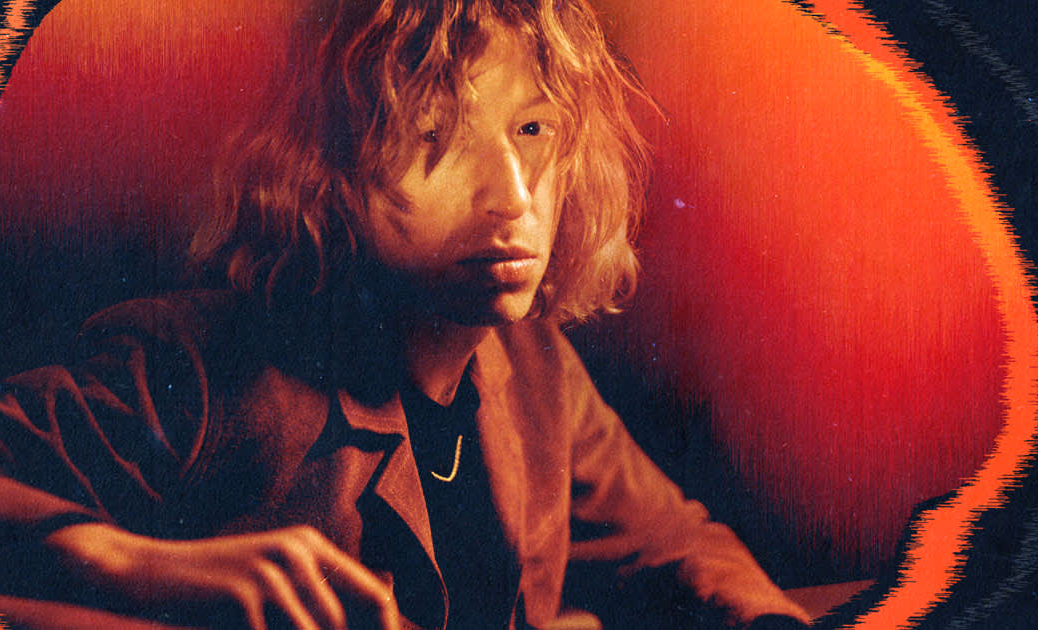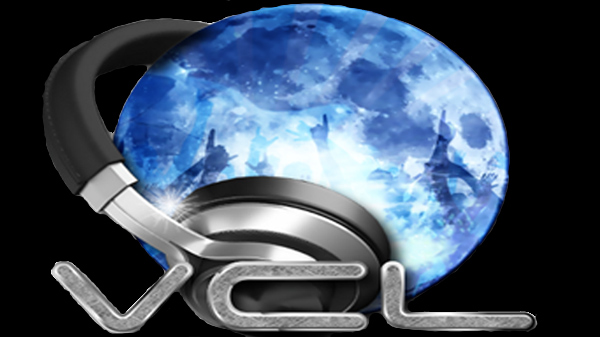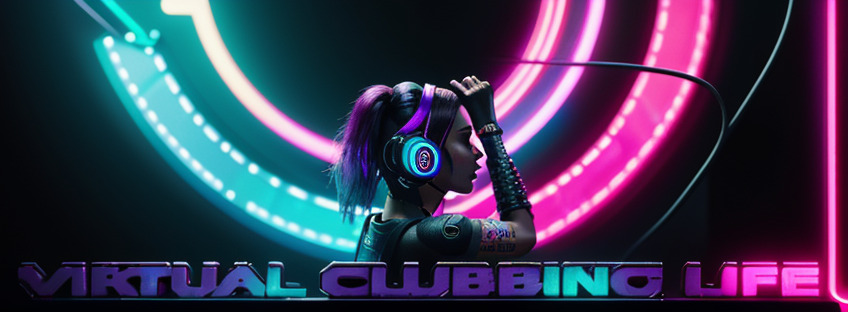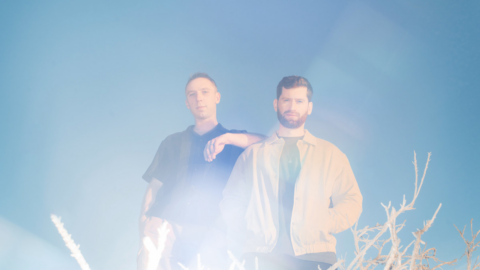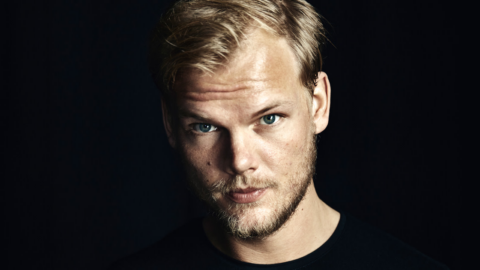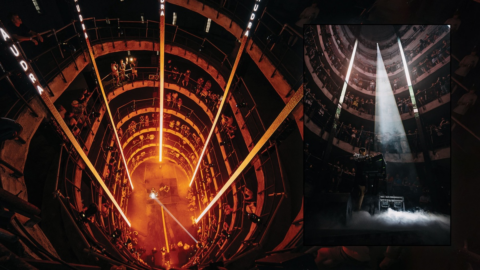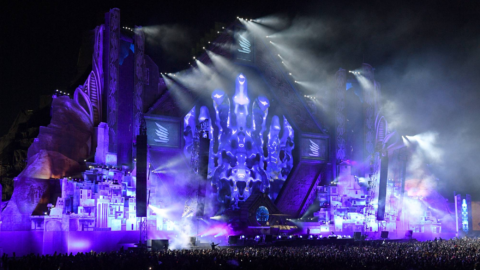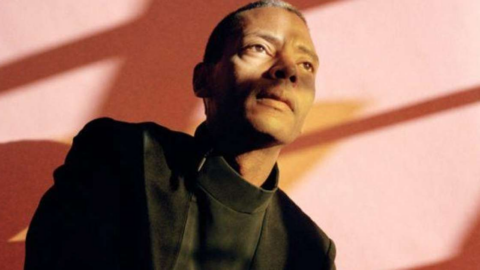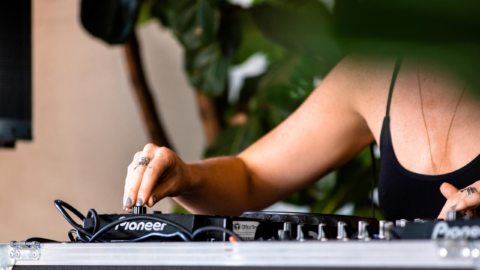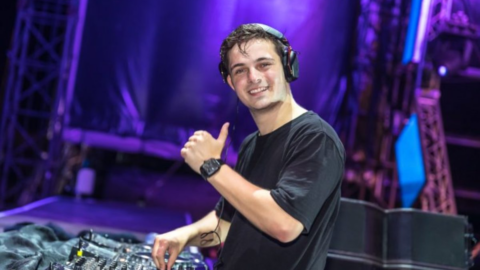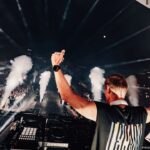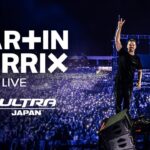It can safely be said that Daniel Avery doesn’t make dance music—rather, music where the dance element is a secondary byproduct. Straight out of the gate, with 2013’s Drone Logic, it was clear that Avery had as much in common with shoegazey acts like A.R. Kane and Flying Saucer Attack as he did with the techno artists he’s often connected with. Music that positively answered the question: “Can an electronic creator be equally influenced by Underground Resistance and My Bloody Valentine?”
Avery’s music has changed with each release—presenting as ambient-leaning one time, more hard-hitting at others—but a disorienting dreaminess has always been part of the equation, particularly in a live context. This year’s Roskilde performance was a pleasant sensory assault, with Avery acting as a guide though set and setting.
“I think I’m mostly known as a techno DJ, but if you consider the music I’ve released, none have been straight-up techno records,” says Avery. “I definitely would not call myself a ‘techno producer.’ What actually comes out is far more song-based, even the stuff that has become known in the club world. So much of it is based on verse/chorus, verse/chorus, because that’s where I come from. Those are my roots.”
“It’s actually led to a lot of frustration over the years. Why am I unable to just make a looping, hypnotic, techno track that doesn’t do very much for eight minutes? All of this being said, I love that music, and while Ultra Truth isn’t a techno record, it has a techno heart. A lot of that make-up is in there somewhere.”
So are elements of drum and bass, the softer side of krautrock, dreampop, found sound, and deterioration pieces that could sit side-by-side with the music of William Basinski. Rather than feeling like an unfocused mélange of ideas, though, Ultra Truth follows a long, compositional arc. Still, tracks like “Devotion” and “Higher” are complete bangers. The two tracks featuring HAAi, “Wall Of Sleep” and “Chaos Energy” (which also features longtime collaborator Kelly Lee Owens) almost stand alone as pocket-sized opuses contained within the greater work.
Ultra Truth is out November 4. Pre-order and pre-save it here.
Do you consider your music psychedelic?
It’s the word I always return to. I often say that all of my favorite music, from wherever it comes, has a strain of psychedelia running through it. Whenever I’m making anything—particularly when I’m finishing it—that is what I would like to inject into it in some way. So short answer, yes, I would call it psychedelic.
I think it began from my dad playing me the first Black Sabbath record. All roads lead back to that. From there it’s less easy to define. Acts like My Bloody Valentine and Aphex Twin share some form of psychedelia that are difficult to describe, but I get a similar sense from both of them.
I would firmly place the unapologetic repetition and hypnotism of Detroit Techno—something else I was drawn to at an early age—right in that psychedelic camp too. Music in which to get fully lost when you’re in a club, closing your eyes, and nothing else seems like it matters anymore. That’s what I get from it. I love everything it stands for. I love the hypnotism of it all. It’s in my music somewhere.
When did you first become aware of the early techno artists? How did it come into your life?
Guitar music was my first love. In terms of club music, I loved things like Underworld, The Prodigy, and Björk. Those were the first electronic records that came into my vision. The big change came when I started following DJs like Andrew Weatherall, or Richard Fearless with Death in Vegas. People who were into things like early techno records, but doing it with an outsider’s perspective. At least that’s how I viewed it. It was thanks to them, mixing so many elements together, that I first realized it was something I could really go for.
To this day you can hear real, forward-facing futurism in the early techno releases. They were reaching for something that’s just out of grasp, in the future, or just beyond our world in some way. A lot of modern electronic producers fall into the trap of trying to be “real” or “genuine” by insisting on only using old equipment, like those artists did; an actual TR-909 or whatever. To me, that’s the exact opposite to what all these original techno pioneers were going for. I think they would balk at such an idea. I like that idea of making something that feels a bit beyond your reach, a bit beyond what you know, and has that psychedelic edge to it.
What made you transition from being a “rock guy” to an electronic musician?
That’s a really good question. I actually still consider myself really to be a rock guy; an indie guy at heart. It’s what I believe my true identity is—strange, seeing as I’ve now made a career out of electronic music.
It’s difficult for me to pinpoint one moment, but there was a time, in the mid-to-late ‘90s, when I was growing up, where those two worlds were intersecting all over the place in interesting ways. You heard The Chemical Brothers talking about New Order as an influence, or Death in Vegas mentioning a deep love for Detroit Techno. Portishead had the darkness and energy of a rock band, but they were also using electronics. Plus Massive Attack, Björk, and all these acts where it was hard to define exactly what they even were. They were melding all of these different elements together. As a teenager it all felt so formative to me.
Nine Inch Nails is a really good example of a band that took both those worlds and combined them into one. You read interviews with Deftones, even now, and they talk about Kevin Shields, or Kode9, as much as they do about their guitar world. I was fortunate to grow up knowing none of these worlds have to be separate.
On top of that, I think the thing that really did it was me moving to London the second I finished university, being led by the hand into these techno nightclubs and the escapism they provided. The community, and the way a nightclub can make you feel like you can represent your true self within them. There’s that moment you’re inside, and the outside world doesn’t really matter that much. I fell in love with that idea immediately, and it really sunk in deep.
To go right back to the first question, to me all of those things share a psychedelic feeling. I get the same sensation from hypnotic techno tracks as I do from a shoegaze record, or Autechre, and Deftones records don’t seem that different in terms of how they make me feel. I cling to that, and believe you can hear all of those influences in what I do.
When you’re on tour do you experience a strong itch to return to your creation space to get going on the next project?
I’ve realized that they have to live in harmony. In the past, those two worlds fought for my attention too much, and it was frustrating. Either I’m not releasing that energy enough by touring, or I’m not spending enough time on the music itself. I think the whole lockdown process rebalanced the two in my head. I know what makes me most content is having a finished track, or record, in my hands. Something that I know is going to last beyond me. I love the touring life. It’s literally taken me around the world, and shown me things that I never thought I’d see, but really the biggest joy comes from making and finishing records. I can safely say that.
Do you ever find that difficult to get to that point where you consider a record finished?
It’s something I’ve had to force myself into. The first album, Drone Logic, is coming up on ten years old. I can’t believe it’s been a decade of this. That was simple, relatively straightforward to make. It was done with a lot of energy, but also naïveté and low expectation. Your standard story of a debut album, and it happened pretty quickly. What came next was that I fell into every single pitfall of making a second album. I did not know how to finish anything. I couldn’t tell if anything was even any good.
Drone Logic launched me into the world as a busy, touring, techno DJ. I’d return home, thinking I was just a DJ now, try to make techno records, fail at it, and become more frustrated. Therefore the second album took five whole years to make. I finally decided this just has to be a time capsule of where I am at the moment, rather than some sort of perfect statement.
Song for Alpha sounds like the search for the quiet moments in between the chaos of tour life, but it took me five years to get to a stage to understand that. Once I realized that, and it was done, it felt like the floodgates had been opened, and I felt so much more comfortable just releasing music. I have a much calmer, healthier way of doing things now.
Ultra Truth has some little nods to the work that led up to it. The opener “New Faith” feels like it could have only happened after your collaboration with Alessandro Cortini on Illusion of Time.
I had an epiphany when I started making music with Alessandro. His process was different to how mine was back then. We’d send each other ideas, and I’d send notes about what I thought should be tidied up. Things I perceived to be mistakes. Alessandro views music in an entirely different fashion. He often believes in the first take. He believes in leaving a lot of humanity in his records. That was an enormous turning point for me. I went from being something of a perfectionist to not only learning to leave in human elements, but even exaggerating them. To turn up the hiss you get from an old machine or to push a bit of distortion that tape gives you. It’s actually now one of my favorite things about making music.
Do you think it’s because of his preferred media? Among other things, he’s a Buchla guy who likes using 4-track machines. You were coming from more of a DAW-oriented world, which often pushes people into some idea of “perfection” perhaps?
I think that had something to do with it, but my issue back then probably ran a bit deeper than just a process. I think I was paralyzed by fear that everything I made had to be a perfect mission statement, rather than what all music and all art actually is: taking an internal idea, then externalizing it, and showing it to the world. I was convinced that I could only offer something I deemed to be a perfect representation of who I wanted to be.
That project was also one of the first things I’d done where it was going to be very much a joint collaboration. Both of our names were going to be front and center. It became an exercise in trust and experimentation, because the majority of it was all made remotely. Most of the tracks were either something that I started and he finished, and that was it, or vice-versa. It was never specified how we were going to work together, we just quickly realized that was how we were going to do things. Then we spent one day in the same studio, piecing together everything we had.
Have there been projects presented to you that you had to warm up to?
I’ve been fortunate that most things have come about pretty naturally, and the timing has felt good. Over lockdown I worked on a few short film scores. That’s something I would like to explore much further, in fact. Just before then I worked on a score for a light installation called Falling Light. Again, it just came about pretty organically. I do firmly believe that if you keep people you feel comfortable with close to you, and keep doing everything in a genuine fashion, then stuff does seem to happen naturally.
How important is it for you to have time to gather input outside from music? Experiencing other forms of art, or listening to the musique concrète aspects of your surroundings?
It’s enormously important. I didn’t give enough weight to it in my younger years. It’s definitely become so much more apparent and important to me in recent times.
I should talk about my studio as it relates to this. It’s a converted shipping container; a metal box in a wharf, right next to the water, in London. It’s in a very secluded, quiet area, and pretty peaceful for being in the middle of the city. I spend as much time down there as I can, even if I have no intention of making any music that day. I might just read a book, or put on someone else’s record, just being down there, in a space that is entirely my own, trying to absorb the world in a different way. I became obsessed with running during lockdown, which I still keep up. I feel that has a very similar effect.
I choose to run with no music. It’s a complete escape for me. It’s one of the rare times where I don’t have anything in my ears other than the surroundings of nature, and that’s become a hugely important part of my life as well.
When you get ideas, during a burst of inspiration, how do you log and scratchpad things so you don’t lose them?
I always carry a notebook with me. Even though most people know me as a musician, I find that writing words down, long-form, is a way that I’m able to express myself best. I studied English at university, and words were important for me from an early stage. Other than a few musical ideas I record to my phone, I would say that the majority of the actual concrete ideas only happen or crystallize in the studio. They are just sort of ideas or concepts before that stage. I’ve never really been able to make music on the road, on a laptop or a plane for instance. I like being in the studio and feeling it that way.
How involved are you in the final mixing and mastering of the music?
The last few records and the new one, Ultra Truth, have all been mixed by Marta Salogni, an unbelievable Italian mix engineer based in London. It’s still a collaborative process. I have a pretty firm idea of how I would like things to be finalized, but she is some sort of magician in terms of actually realizing that, particularly on Ultra Truth. I kept repeating this idea of wanting things to be pushed as far as they can, just before a breaking point. I find that moment, just before something cracks, really exciting. She completely loved that idea and really grabbed it with both hands. Her sound is an enormous part of the record. I don’t have any technical knowledge in terms of mastering itself. I know what I want it to sound like, though. It’s a collaborative process, so I’ve always worked with trusted people.
What are some collaborative moments that stand out as particularly constructive to you, or even direction changing?
There are two big figures in my life I should mention. Manny D is mostly known for being an industrial techno producer, but he also makes anything from hip-hop to hyperpop. His fingerprints are on every single track of the new album. I turned to him for a lot of finalizing moments related to the sound design itself. He lent his expertise, and input, to the overall sound of the past few records really, but particularly Ultra Truth.
It was Manny who encouraged me to keep pushing this idea I had in my head of a distorted, yet beautiful record, that I knew I wanted to make. I wanted it to sound like it was on fire for its duration. When I took a step back from Ultra Truth I really felt I’d achieved what I set out to do, more so than any other record that I’ve finished. Manny’s encouragement was a big part of it.
The other constant bit of collaboration that I’ve done, since even before Drone Logic, is with a guy called James Greenwood, who goes under the artist name Ghost Culture. I met James and Kelly Lee Owens at the record shop where I worked, 15-odd years ago. When I first met James he was 18, and fresh out of music production college. Someone suggested we get into the studio together. It started as him just helping me engineer, but then some magic appeared. He was throwing out ideas, and I was throwing them right back. It quickly developed into something far more fruitful, to the point where Drone Logic is very much a collaboration with James. It’s my record, but James has writing credits on everything, because it wasn’t enough for him simply to be listed as the engineer.
My favorite experiences are when I’m not just on my own in the studio. I really love the energy when someone else is there, and things can be achieved quickly. I don’t know anything about filmmaking, but I’d imagine it has some similarities to how a director may feel when working with an editor or a cinematographer, and ideas are flowing back and forth. The director still has the final say about the final cut, but bringing in trusted people who can add something to the finished product is really exciting.
There is a lot of mystery related to the process of doing a remix. Can you walk us through that?
Yeah, of course! I’ve always been fascinated by the idea of a remix, and what defines one. I think of it as taking another artist’s track and putting it through your own filter; through your lens, and seeing what comes out the other side.
In terms of how it actually works, say a band or label comes to me and asks me to remix a track. Since I spend a lot of my time out on the road as a techno DJ, more often than not people ask me to take the song from one environment, and turn it into something that can fit into a club set. They give me the stems – the parts to their track – then I get into the studio and go through all of them. I find the things that immediately jump out as interesting, and can be manipulated, then discard the rest. I like to work very quickly and think, for me anyway, the sweet spot is spending between one and two days on it. Any longer and it starts to lose energy for me. Then I hand it back to the label or artist for final approval. I feel fortunate that I’ve reached a stage where people trust me to do something interesting with their music.
I should say that whilst I mention making things that are playable for a nightclub, I don’t think that’s the sole reason, at all, for doing a remix, and not everything I do comes out as a club track. I just believe in the ethos that it’s simply one artist’s vision fed through another’s. Whatever comes out the other side comes out.
To reverse the roles, I’ve had many remixes done of my tracks. I only ask people I massively respect and quite often it’s someone I’ve had some form of contact with, from traveling, or meeting along the way. I prefer to give zero notes to whoever’s doing it, and embrace whatever comes back. It’s fascinating to give your ideas to someone and have them create something with it. It’s not about tidying up or improving anything, it’s a completely artistic transaction. How do you see it, and what’s your take on this music?
I love it when a remix of my music comes back and it’s entirely different from what I sent them. I’d actually be a little disappointed if it had just been returned to me slightly shifted about, and didn’t show some genuine vision. I like it when things come back warped, manipulated, and shaped in a way I’d have never have thought of. That’s the exciting bit! A kick can sound like that, or that vocal could be used in that way? That’s inspiring.
How do you arrange your set for live performance? How is it different from a DJ set?
So this is a world that’s still pretty new to me. I started DJing, and making music in my bedroom, as a teenager. I played in bands as a kid, and that’s the path I thought I was going to go down, but DJing really took over my life when I was 18. I just turned 37, and I’ve been DJing pretty much every week the entire time, so that’s half my life. It is very much a part of me. To present myself as “Daniel Avery Live” was something I wanted to do all along, but I only started a couple of years ago, because I didn’t know how I wanted to do it. There are so many different ways to do it! I truly admire people who take all of their gear on stage and improvise, leaving so much to chance. I’m so fascinated by artists who do that.
I knew when I finally took the plunge I wanted to present an experience above everything else. What I’m presenting now is as much a light installation as anything. Moving forward, it’s going to become even more of an AV installation, and full body experience. It’s still a work in progress, but the idea is to make it something with a different weight and energy than a guy who is just standing behind a table.
When I play live, I purposefully leave gaps between sections between songs, like a band would. The DJ thing is still a hugely important part of what I do, but that’s about slow builds, gradual transitions, and something you can get lost inside. I’ve done 8 or 9 hour DJ sets where there is not not one gap. Every track is blended in some way into the previous one.
For the live show I want to offer something totally different from that. I want to go back to those gigs that blew my mind as a kid. Rock bands, metal bands, shows where you walk away with your eyes full of strobes, your ears are ringing, and it’s been the most intense, unforgettable hour of your life. That’s the goal for the live show: something you can’t ignore. That’s how I’m differentiating the two in my mind.
It all means a lot of the work gets done in pre-production. On stage, of course stuff is being triggered, manipulated, and processed live, but there has to be an element that is synced up in order for it to feel like an experience, above everything else. This summer’s Roskilde show was one of the very first of this iteration, and it’s already grown beyond that.
Has there ever been a time where a piece of equipment malfunctioned, didn’t work as planned, or created a happy accident that absolutely made the track?
It’s been particularly interesting going back to the stems from Drone Logic. Hearing how bizarre the timing is on some of the tracks has been eye-opening. It’s because so much of it was written using sequencers. The whole album was made with a Korg Mono/Poly and a Roland SH-101. There were a couple of other things, but the engine of that album is Mono/Poly and 101, including all of the drums. Basically every single kick on Drone Logic is made by a Mono/Poly. Going back through the stems you can hear that, because every hit is different. Everything is being fed through sequencers and has a really strange groove to it.
It’s created some issues putting it into a live set. The timing is so loose that it’s been a bit of an uphill battle getting it to work with some of my newer stuff, but I also feel very good about that. It makes me feel happy, and shows Drone Logic was not an album that was labored over. Whatever came out, came out, and it sounded good to my ear at the time. So I wouldn’t call them mistakes but, I don’t know, if you were to just place them on a grid, a lot of it really wouldn’t make much sense! In some ways, that entire first album is something of a happy accident, or at least a naive way of making club music.
This also speaks to the question of is it necessary to spend $5,000 on a TR-808 rather than finding the next 909 for $100, or working with what you have?
I completely agree! And to push that idea even further, I think the most interesting sounds I’ve come across, or made myself, have been with found sounds. From the Cortini record onwards, I’ve become fascinated with the idea of contact microphones, and making a snare drum out of a bit of metal, or using a layer of ambient noise, or hiss, just recording the sound of air from outside my studio. You would never be able to write anything like that. I wouldn’t, at least.
Using found sounds for kick drums and hi-hats? That’s how you change the whole dynamic. As with anyone, there have been times when I’ve thought I needed more technical know how. I watched videos on tuning kick drums to a track, tried it, and I just thought “this is fucking boring!” It’s so boring! All I’d done was make the track sound more generic. I would say, to anyone who is interested in making music, just scrap those ideas immediately. You’ll drive yourself crazy trying to tune your snare drums to your synths, and all the rest of it.
Dissonance is something that should be celebrated, not hidden. That’s where ideas can come from. That’s where things that really excite me all lie.
When you collect these hisses and sounds of whacked pieces of metal do you tend to throw them into a sampler, then play with them organically?
Yeah, I like doing that. I also love distorting things in quite extreme ways, stretching, warping them, just taking something that you had no idea could sound a certain way, and turning it into something else entirely. I’ve really fallen in love with quite a few plug-ins over the past few years that do things like that.
There’s a distortion unit from FXpansion called Maul. There’s the Saturn distortion unit that FabFilter makes—basically a distortion and an EQ unit in one. Distorting different parts of a found sound has just changed so much for me. I’m fascinated with the idea of taking things from the real world, forcing them into what you’re doing, and seeing what comes out.
You seem to get a lot of use out of the Roland JX-3P.
Oh, that’s across so much of my stuff. Taking that and just flooding it with reverb from the Valhalla Vintage Verb? That alone has been such an enormous part of my sound for several years now. It’s all over the new record. I prefer them [over synths like Juno 60s]! There’s something about the tone of them that is perhaps a little less harsh.
I’m lucky my JX-3P has the PG-200 so I have more control. I feel like the JX-3P has a duller sound than a Juno, but that’s what I like. It’s a floatier, spacier sound that I can get to sit well within a track. It’s not necessarily as good for a lead as a Juno, but perfect for creating ambience or a layer. I just love layers within tracks, and the JX-3P is wonderful for that.
What aspects of your career do you consider to be a product of the Internet or streaming age that maybe wouldn’t have existed had you been an artist in a previous time?
Well, I have two answers here. From Drone Logic onwards things happened very, very quickly for me. I went from someone who nobody knew to being able to touring the world, playing sold out shows in Tokyo or Sydney. Who knows if that could have happened with music like mine, previously. Maybe, but I get the sense that Drone Logic was a word-of-mouth record, and people were sharing files with each other. That’s certainly how it felt.
Another real standout moment for me was the creation of Illusion of Time with Alessandro. As I mentioned, we were not in the same room for 90 percent of the creation of that record. Instead, we were both traveling around the world touring, waking up in different countries, different cities, and passing these ideas to each other. I’ve described it before as sending these electronic bolts of energy to each other in different time zones, then reacting to them. It would have been so much more difficult to find the time and space to have made that record if we’d had to be in the studio together. I don’t think that record could have been made any other way. It felt free, and we did not have the burden of pressure. It just felt like a love letter to electronic music itself. Every incremental moment in its creation was nothing but a joy. It happened in an extremely modern way, and I really love it for that.
Your purchases help youth music programs get the gear they need to make music.
Your purchases also help protect forests, including trees traditionally used to make instruments.
Hey! Based on your location, we've changed your settings:
Shipping Region: France, Currency: EUR Learn More
We understand the importance of online privacy and are committed to complying with the EU General Data Protection Regulation. To reflect our commitment, we updated our terms and conditions. By continuing to use Reverb, you agree to these updates, and to our cookie policy. Learn More
